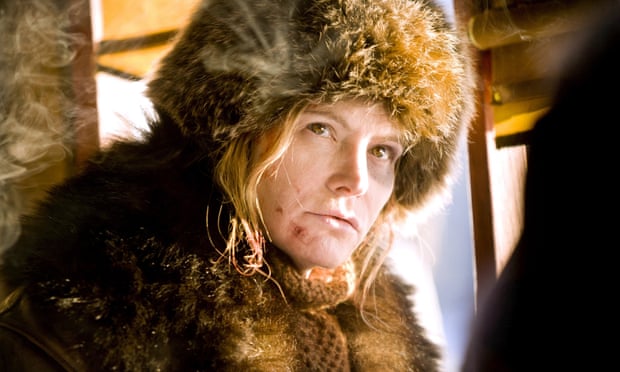The Hateful Eight, Tarantino’s latest blood splattering, head-popping epic, has moved some to criticise the film-maker for his treatment of the only female protagonist of the titular octet, Daisy Domergue - grimacingly and grittily played by Jennifer Jason Leigh.
Tarantino, perhaps despairing after suffering over two decades of journalists whining about merciless violence, responds to this latest accusation with something akin to bewilderment. Why should he be expected to spare one of the villains simply because of her gender?
Exactly. The clue’s in the title. Hate breeds hate - and vengeance - not mercy or redemption.
…Tarantino can never be accused of glorifying violence against women…
While some eschew Tarantino’s films for their breathtaking killing sprees, he can never be accused of glorying in violence against women. Female characters invariably hold their own. In Kill Bill, a trilogy in which the protagonists are almost entirely female assassins, the sexual assault of the Bride, while she is unconscious in hospital, occurs off camera, unlike her subsequent bloody revenge.
Hateful’s Daisy Domergue is no less ruthless, but no figure-hugging catsuit for her. She is a gang member, living a hard brutal existence on par with men. She is as foul-mouthed, vulgar, defiant and blood-thirsty as any of the film’s male characters, and thus ‘unfeminine’ in every aspect.
But society’s norms regarding women’s behaviour, have hardly really shifted since the period this film is set, over a hundred years ago. If anything, women’s sexuality is exploited more blatantly than ever thanks to the cross channels of global media.
But there’s nothing sexy about Daisy Domergue and, significantly, despite being held in chains amongst a den of cut-throat murderers, she is not targeted for sexual assault or exploitation by any of the characters. The only time she lets down her hair and sings prettily to a guitar, she does so to mock her captor, John ‘the hangman’ Ruth.
Tarantino does shock with depictions of sexual violence, but it is conducted by men, against men. Who can forget Pulp Fiction’s infamous ‘Gimp’?
…But society’s norms have hardly really shifted since the period this film is set…
And in The Hateful Eight, Samuel L. Jackson’s character, Major Marquis Warren, gleefully depicts his torture and sexual assault of a white male bounty hunter. It was, we learn, a retaliatory act for the war crime of his victim’s father. And this awful confession, which reveals the horrifying extent of Warren’s cruelty, brings to a climax the vicious racist sparring of characters still living in the shadow of the Civil War.
The audience, hours into this tense battle of wits and sleight of hand, might wonder what could possibly trump such deep-seated racial hatred.
Well, perhaps deep-seated misogyny.
Until the very end, we are unsure where would-be sheriff, Chris Mannix, will place his alliances. This is a character who has established himself as immensely proud of his father’s military role and so, surely not one who will side with a black man guilty of murdering both a Confederate General, his son and allegedly slaying white soldiers without regard to their allegiance?
But, given that Mannix’s only other choice is to side with Daisy, he chooses instead his erstwhile enemy. Could this be proof that hatred for a woman who eschews her proscribed role far exceeds that for a black man daring to command equality with whites.
Warren, author of the bogus Lincoln letter lionising Mary Todd Lincoln’s domesticity, and who we can infer had a longstanding friendship with homely, caring Minnie in whose haberdashery we find the characters trapped, has no less contempt for Daisy. It is his idea that rather than shoot her, she should suffer a far more protracted death. Mannix eagerly agrees. He wants to punish her for not acting to protect him from being poisoned.
Warren and Mannix lie back, slowly bleeding to death on Minnie’s mattress, as generous and cushiony as her bosom was in life, and watch Daisy’s slow strangulation with the satisfaction of justice well-served.
…On the surface it looks rather like comparing an ocean liner with a stagecoach…
It is this final scene that evokes an unlikely bedfellow for a modern shoot-em-up Western: the recent BBC dramatisation of Agatha Christie’s And Then There Were None (originally Ten Little Niggers…Ehem!).
On the surface it looks rather like comparing an ocean liner with a stagecoach, yet both stories end with the portrayal of a woman being hanged by self-appointed male arbiters of justice.
Indeed, this is not the only parallel. In both cases the audience is intrigued by the suspense of suspicious, cagey characters trapped inside a building, carrying their own guilty secrets close to their chests. And by the end, no one is beyond the savage justice visited upon them for their crimes. Particularly not a woman who shirks her duty of care.
Tarantino might well argue that if Agatha Christie does not spare her female character, why should he?

No comments:
Post a Comment